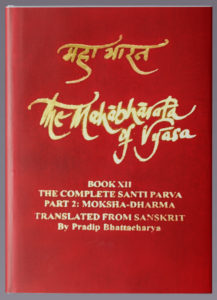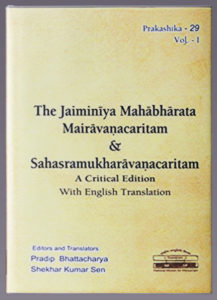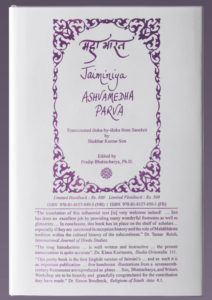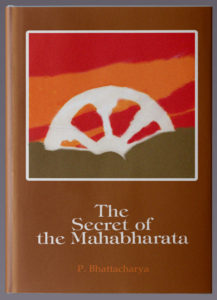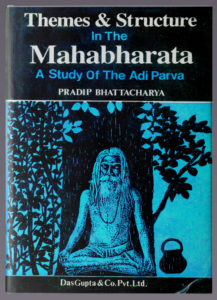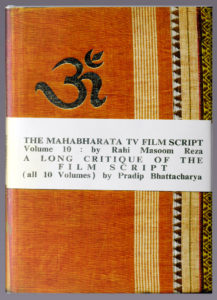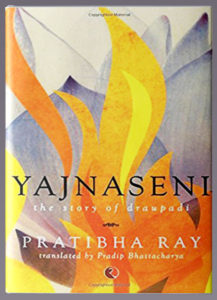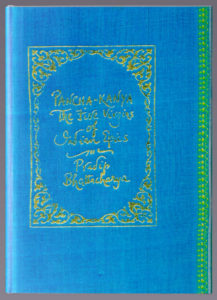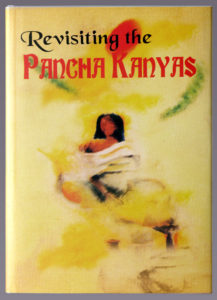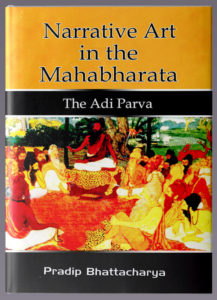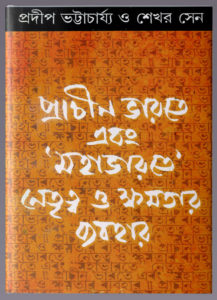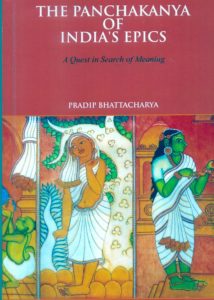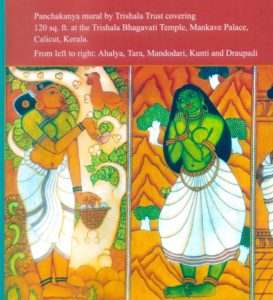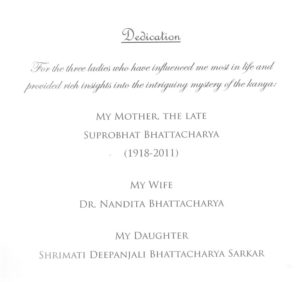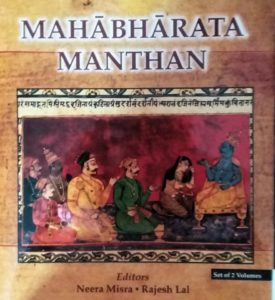The Complete Vana Parva translated by Prof. P. Lal
The forest in Bharatavarsha is not just a savage jungle where man reverts to the bestial. On the other hand, the very fountainhead of our civilization lies here, its helmsmen being the seers and sages, a place where man lives in harmony with nature. We stumble across hermitages resonant with the chanting of mantras, fragrant with the smoke of yajnic fires, holy teerthas to purify oneself. Yet, it is a mysterious world peopled not just by the usual denizens. Suddenly the blood freezes, accosted by terrifying shape-shifting demons and pythons hissing human speech, enchanting lakes guarded by Yakshas and Rakshasas, deceptively pellucid waters on whose banks lie corpses. Here woman faces down immutable, inexorable Death itself. That is why Tagore saw in ‘tapovan’, the forest of ascesis, the very soul of Bharata.
In Vyasa’s creation, the twelve years exile of the five brothers and their wife is not simply a period of inaction. It is an interval providing an opportunity for turning away from the external world and the extrovert personality to look within. The only one who does so is Yudhishthira, so ill at ease on a throne in a tumultuous capital city. He may well say with Andrew Marvell:
Fair Quiet, have I found thee here,
And Innocence thy sister dear?
Mistaken long, I sought you then
In busy companies of men’
Meanwhile the mind from pleasure less
Withdraws into its happiness;’
Annihilating all that’s made
To a green thought in a green shade.
More mature than when they suffered their first exile in the forest of Hidimba, anguished by the incidents in the royal court, Yudhishthira repeatedly seeks guidance from seers and sages, eager to reach that state of which the Rig Veda and the Svetashvatara Upanishad speak:
Casting the body’s vest aside,
My soul into the boughs does glide;
There, like a bird, it sits and sings,
Then whets and combs its silver wings,
And, till prepared for longer flight,
Waves in its plumes the various light.
By the end of the Vana Parva, when he has satisfied the disguised Yaksha and won resurrection for his brothers, it seems that he may have approached it.
However, the forest exile is not a blissful sylvan break for the Pandavas. At Yudhishthira’s command, they have to take up arms to rescue their tormentor Duryodhana from the Gandharvas. Twice Draupadi is abducted’once along with three of her husbands who are helpless till Bhima turns up’and then by Jayadratha. Twice Draupadi inveigles Bhima into reckless confrontations with Yakshas and Rakshasas to satisfy her fancies. During their journey to meet Arjuna, Draupadi is first to collapse on the slopes of Gandhamadana, presaging the scene of the final departure, with the difference that her husbands rush to her rescue. Twice the story of Rama is brought before them: once to Bhima alone by Hanuman and then to Yudhishthira by Markandeya as an example of an exiled prince. Twice Bhima is taught the limits of his strength: once by his ancestor Nahusha-turned-python and next by his stepbrother Hanuman. Death is confronted twice, and on both occasions he gives in to the integrity of the human being. Yudhishthira is groomed for his final confrontation with the deadly Dharma-crane through the questions Nahusha puts to him, the dialogue between Savitri and the lord of death, and the many stories that he hears from the sages, notably those of Rama-Sita and of Nala-Damayanti in which the themes of dicing, exile in the forest, battle and restoration are repeated. The exile itself is doubled for the audience: the story of Rama’s fourteen year exile is recounted as a parallel to the Pandavas’ thirteen year ordeal.
The Vana Parva consists of eighteen chapters—a significant number in this epic of eighteen books whose climax is the eighteen days war. Much of it is taken up by a description of pilgrimage spots, as many as 350, related by Pulastya (235), Dhaumya (53) and Lomasha (60) in over 2400 verses. Similar accounts are found later in the Shalya Parva (43 spots in 77 verses) and the Anushasana Parva (81 in 66 verses). The interesting point is that these are not just magically cleansing lakes or river-crossings. Pulastya clarifies that visiting them is of value only if the visitor has faith and is pure of heart. It is here that for the first time we find a deliberate attempt to describe pilgrimage as an institution which became a feature of the Puranas. These descriptions came to dominate Indian cultural geography, covering practically the entire country with the idea that encouraging people to visit these in a circuit would foster cultural mingling and unity. Tagore points out that through the rivers the consciousness of the receptive human being touches the Supreme Consciousness, cleansing him of the layer of illusion.
The first chapter begins with the hermit Shaunaka (again a parallel to the sage to whom Sauti narrates the epic) reading the Pandavas a lesson in desire being the root of all misery, which reiterates the realisations of Yayati in the Adi Parva. He also provides Yudhishthira the core teaching of Karma Yoga by saying that the message of the Vedas is to do karma, but renounce its fruit; perform dharma, but take no pride in doing so.
In the second chapter, where Krishna visits the Pandavas, we find him explaining his absence. This is the first clue that his miraculous rescuing of Draupadi from being stripped is a later interpolation. When Draupadi upbraids Krishna, her ‘grief-rich tears’ drenching ‘her heavy, round, lovely breasts’, she does not refer to the attempted disrobing, only to being dragged while menstruating but specifically mentions being mocked by Karna. The transcreation captures the anguish in simple words flying straight to the mark:
‘Husbands, sons. Relatives, brothers, father,
I have no one. No one. No one.
Not even you, Madhusudana-Krishna’
Keshava, Krishna,
There are four reasons you must help me.
Am I not related to you?
Don’t you respect me as a woman?
Am I not your loved-and-loving sakhi?
Haven’t you vowed to protect me?’
How true the first two lines are about her situation at the end of the war! In response, Krishna makes his famous vow in words that echo those of Devavrata making his ‘Bhishma’ vow:
‘You will be rani of rajas!
The skies will fall,
The Himalayas shatter,
The earth split in two,
The ocean’s waters dry up’
But what I promise you, Krishna-Draupadi,
Will not fail to happen.’
In the process, ironically, he dooms himself and his entire clan.
The Parva provides a veritable cliff-hanger with its account of Karna deliberately giving away his impenetrable armour and celestial earrings for the sake of fame. This account also provides one of the several accounts of his birth, with a detailed narration of how Surya browbeat the adolescent Kunti into giving in to his demands. There is an interesting hint here of a shared identity between Durvasa and Surya, both described as being madhupingala in complexion.
In Puranic accounts, Shri leaves the demons and goes over to the gods to become Indra’s ‘good fortune and prosperity’. Draupadi’s insistence on accompanying the Pandavas into exile is, therefore, doubly significant: their Shri has not abandoned them. Throughout the exile she constantly badgers Yudhishthira, desperately and tirelessly labouring to arouse in him a desire to win back what she symbolises and which he has gambled away. When Jatasura abducts Draupadi along with the twins and Yudhishthira, her eldest husband’s warning to the Rakshasa contains a significant revelation of her destructiveness:
‘In touching this woman you have drunk a jar of well-stirred poison.’ (III.157.26)
While she is like a boat to her husbands, saving them from drowning in the sea of distress, to the wicked she is death itself. Throughout the thirteen years of exile she never allows her husbands and her sakha to forget how she was outraged and they were cheated of their kingdom. The marital relationship between Draupadi and the Pandavas is constantly that of a mahout goading an elephant into the fray. Krishna’s urging Yudhishthira in the forest that karma and individual enterprise, purushartha, are indispensable to preserve society and one’s integrity anticipates her sakha Krishna’s discourse to Arjuna on the battlefield. She is the only one among the Pandavas and Kauravas who assumes the atheistic stance in a violent outburst, exclaiming (III.30.23, III.32) that creatures are like wooden dolls (darumayi yosha) in the hands of a whimsical creator, recalling the significance of her own name Panchali, anticipating King Lear’s heart-wrenching ‘As flies to wanton boys are we to the gods/They kill us for their sport’ and Hardy’s ‘the President of the Immortals had ended his sport with Tess.’ This is part of the political science she learned, listening to a learned Brahmin discoursing to her father and brothers (III.30.60-61). It calls forth Yudhishthira’s plea to abandon such nastika heresy She gives this back in full measure after the war when he wishes to become a hermit, by saying that were his brothers not equally crazy, they would have tied him up as an atheist and ruled the kingdom themselves (XII.14.33).
The complete account of income and expenditure of her husbands was in her grasp and she alone knew the extent of their wealth. She kept track of what each of the many maidservants attending on her husband was doing. It is she who used to make all the arrangements for Yudhishthira’s tours, keeping count of the large retinue of horses and elephants and their quartering, laying aside her own comfort (III.233.458).
Another piquant passage is the conversation between Satyabhama and Draupadi. Krishna’s favourite wife is insecure and worried stiff over how to keep his interest active. Draupadi gives her a long lecture on wifely duties, which has the marks of a later interpolation all over it. However, it has some very interesting insights such as that she took care never to complain about her mother-in-law, whatever the aggravation; never surpassed her in ornaments, dress and even the food taken. The healthy respect the Pandavas had for her has been well brought out in Rajshekhar Basu’s delightful take-off, ‘Panchali, beloved of the five‘[i].
We come across interesting insights such as the duel between Bhima and the Rakshasa Kirmira being compared to Vali and Sugriva clashing over a woman. In the Ramakatha that follows later, Vali suspects that Tara is dissuading him from responding to Sugriva’s challenge because she favours him. Valmiki’s epic is innocent of this hint, which was part of the older tradition. The Ramakatha has many other interesting differences from the Ramayana, such as Manthara being the gandharvi Dundubhi reborn sent by Brahma to bring about Rama’s exile, Sita being consoled by a Rakshasa named Avindhya who is richly rewarded by Rama. Lakshmana is seen, in a dream, to be licking boiled milk and honey rice on a heap of bones, precisely the image applied by Karna to Yudhishthira in his discourse with Krishna in the Udyoga Parva. There is no burning of Lanka by Hanuman, nor does he carry Rama’s signet ring to Sita, no fire-ordeal. The story ends with the return to Ayodhya.
Besides these major kathas, there are shorter stories about Agastya’s feats, Rishyashringa (again a link with the Ramayana), thousand-armed Kartavirya Arjuna, Mandhata, Dhundhumara, the hair-raising account of Somaka sacrificing his only son Jantu to beget a hundred sons, the self-sacrificing generosity of Shibi, Ashtavakra, the unusual story of Yavakrita which Girish Karnad turned into a remarkable play Agnivarsha, Chyavana-Sukanya and Parikshit-Sushobhana the heartbreaking frog-princess (turned into wonderful love stories by Subodh Ghose), the peculiar story of Indradyumna’s search for someone who remembers him, the birth and victory of Skanda that inspired Kumarasambhava.
There are some unusually ‘subaltern’ didactic stories that show the superiority of dedication to duty over asceticism (the devoted wife, the righteous butcher, the householder Brahmin Mudgala).
The climax of the Parva comes in the questioning of Yudhishthira by the Yaksha, where the depth of the Pandava’s wisdom is plumbed and not found wanting. It his dedication to anrishamsya, non-injury, that wins him the favour. That is when he is found fit to regain his kingdom in future and given the boon of not being recognised in disguise during the incognito exile period. The interaction contains some gems of insight that encapsulate in just a shloka the most profound truths of existence, such as:
‘That man is happy who,
Nor in debt and not in a foreign land,
In his own home, in the fifth or sixth part of the day,
Cooks a vegetarian meal and eats it.
Every day creatures die. They go to the realm of Yama
Yet everyone thinks he will live for ever.
What is more wonderful than this?’
This is also where the famous epigram, ‘Dharma violated destroys; Dharma cherished protects’ is spoken by Yudhishthira.
The transcreation is all through extremely reader-friendly, in rhythmic free verse. There are few errors, one of which is in the Ramakatha where in a dream (280.71) Sita is said to be proceeding south, the deathly direction, whereas the original has north. The volume is enriched with 123 facsimile reproductions showing the extensive revisions and note made by Prof. Lal to his original version for his weekly readings that began in October 1999. 4 pages of errata to the Adi and Sabha parva volumes are added.
The Introduction to the Mahabharata is a reproduction of what introduced the single volume condensation of the epic published in 1980 that remains unparalleled in English for its masterly selection of material and is the only one that effortlessly shifts to poetry where necessary. It is Prof. Lal who first called it ‘the Doomsday Epic’ and this introduction shows why the epithet is deserved. Besides the hard-core narrative, there are excellent thumbnail sketches of the major characters concentrating on the psychological mainsprings of action, and an insightful section on the message of the epic which contains a superb retelling of the Kalpataru parable. His conclusion is that the meaning of life lies in compassion, without which you end up with doomsday. It ends with a valuable discourse on the challenges of translating Vyasa.
The portfolio of Mahabharata paintings makes available paintings from Ramananda Chatterjee’s edition of Kashiram Das’ version of the epic in Bangla verse. Most artists belong to the Bengal Renaissance school, but there is Ravi Varma as well and some miniatures. One Ravi Varma painting depicts Simhika leading Draupadi, an incident known in the South but absent in Vyasa. In addition to these, the book provides the text of Prof. Lal’s brilliant valedictory address to Sahitya Akademi’s 1990 international seminar on the Mahabharata. To read it is to realise the profundity of insights hidden in the simplest of stories. Prof. Lal takes up four, some of which travelled all the way to the West to become famous as ‘Barlaam and Josaphat’, the tale of the man in the well. A veritable cornucopia indeed!
